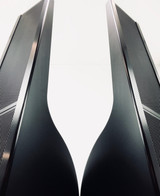Shockingly good

My coworker Dan could tell that fall was in the air last week, evidenced by the familiar crackle of static discharge returning to interactions with his testing station’s metal rack. “My favorite time of year,” he said as I heard another SNAP come from his direction.
Colorado’s dry air and our fleece-ey insulating layers make us more familiar than some with the generation of static high voltage and related effects. A fun trick when you’re camping here in the fall is to put on wool long johns and shirt, get in your sleeping bag and start moving. The resulting light show can be very interesting.
Static is a part of life out here, for sure. And way up in Colorado’s little mountain town of Conifer, a man named Roger Sanders knows a little more than some about another kind of ‘static: electrostatic loudspeakers.
Roger, inventor of the curved electrostatic panel and author of The Electrostatic Loudspeaker Design Cookbook is a man obsessed, and he’s taken this fascinating science to epic heights. Forget the scores testimonials from his fans around the world — when The Absolute Sound says this about his latest creation, there’s probably not too much more to say anywhere:
“In my view, no one speaker could be justly declared “the one and only world’s best” because exactly what a speaker in a room is supposed to do is not something that is completely and scientifically agreed upon.”
“… But if you wanted to call the Sanders 10e the best speaker ever, you could definitely make a case.”
Interestingly, quite a few years ago Roger developed the curvilinear electrostatic panel, which speaker manufacturer Martin Logan uses extensively in their lineup, even today. Yet, looking at Roger’s designs over the years, from Georgia-based InnerSound to the current Sanders Sound Systems up in Conifer, you do not see any curved designs.
Just like the inventor of IEMs (In-Ear Monitors) Stephen Ambrose, whose subsequent research moved his interests away from his original invented design, Sanders now uses only flat panels in his products, as he prizes the benefits of a flat panel over the improved dispersion characteristics of the curved approach. Those benefits include better transient response, better holographic imaging and improved frequency balance.
The trade-off, as there is never a “free lunch” in our game, is that the sweet spot for flat panels is smaller than with curved panels. If you’ve ever been to one of the impressive demos of Sanders panels at an audio show, you probably saw a thin column of seats all placed in the sweet spot. A bit unconventional, but when you’re sitting in one of those seats, it is fully apparent to you that these speakers are for serious listening, and serious listening involves staying in one place. Not the worst compromise, if you ask me.
Still, some aren’t excited about being held prisoner in their listening chair, and for them the curved electrostatic panel design provides a bit more freedom to go along with the wonderful speed and musicality of good electrostat speakers.
The reason I’m writing about all of this today is this week has been unofficially dubbed “electrostat week” by tester Ben and me, as we’ve been working through the test process for quite a few wonderful-sounding electrostatic speaker systems. Included in the list are several pairs of flat-paneled hybrid electrostats from Roger’s previous company InnerSound, and two which use his 600-watt Series 2 crossover/bass amplifiers to control them.
Meanwhile, TMR’s stock of Martin Logans has been dwindling as buyers have been snapping up the popular curved-panel designs left and right. Currently (pseudo-pun intended) we have ML’s top of the line CLX speakers in stock, though they may not last beyond the next week I’m hearing, and a lovely set of Quad ESL 2912s as well. Both incorporate a curved panel, while the Martin Logan CLX combine curved and flat panels in their arrangement.
Over the next week we will be rolling out these lovely electrostats from InnerSound, so stay tuned and keep a sharp eye on our Fresh Arrivals page.
